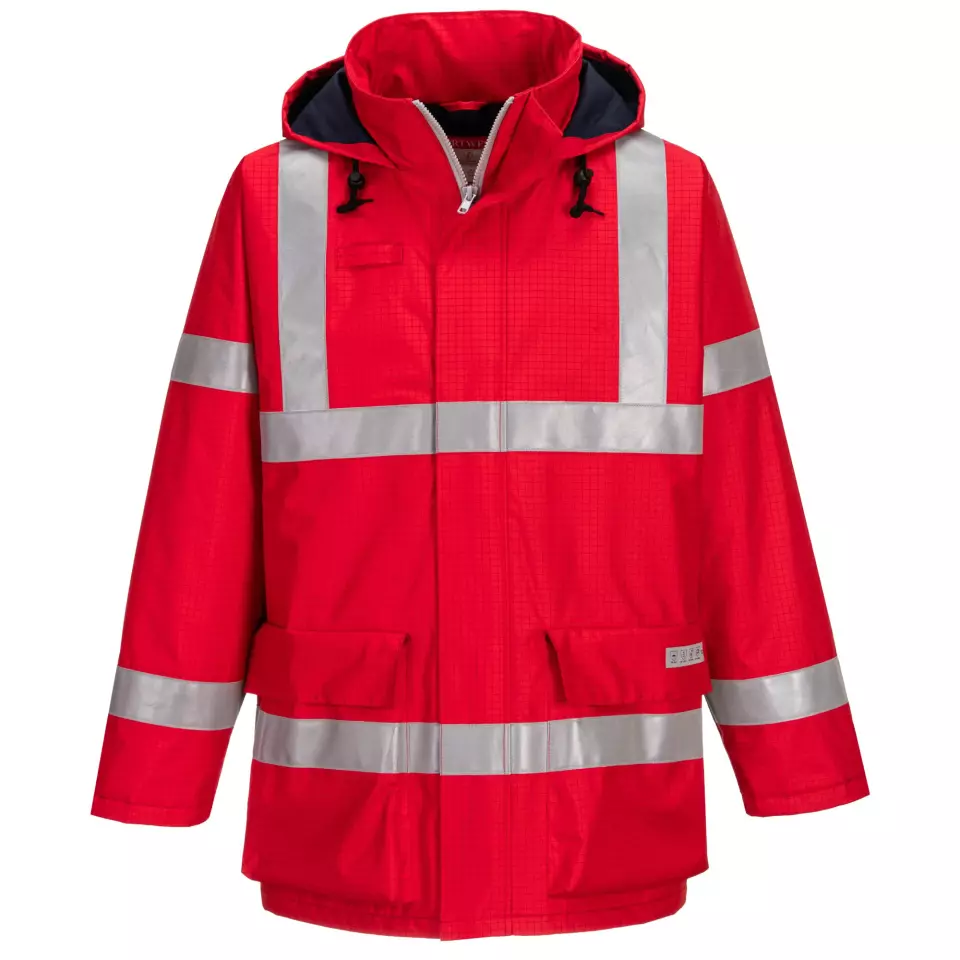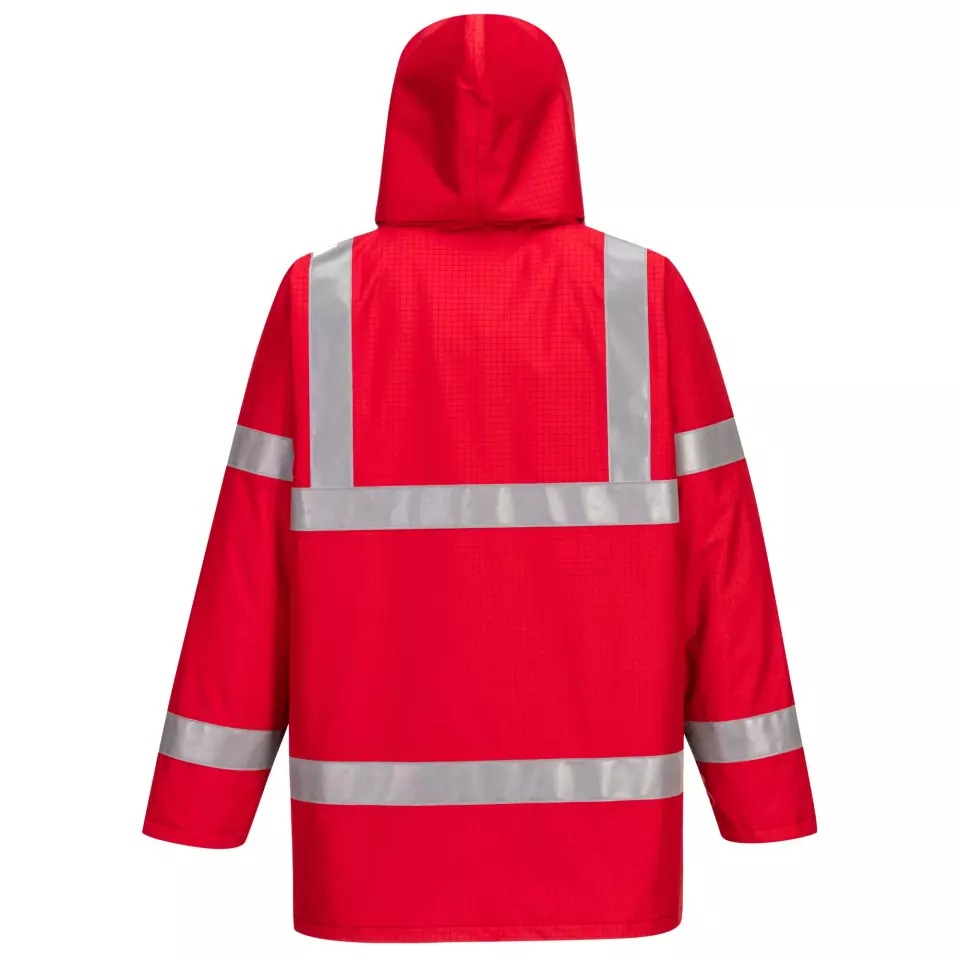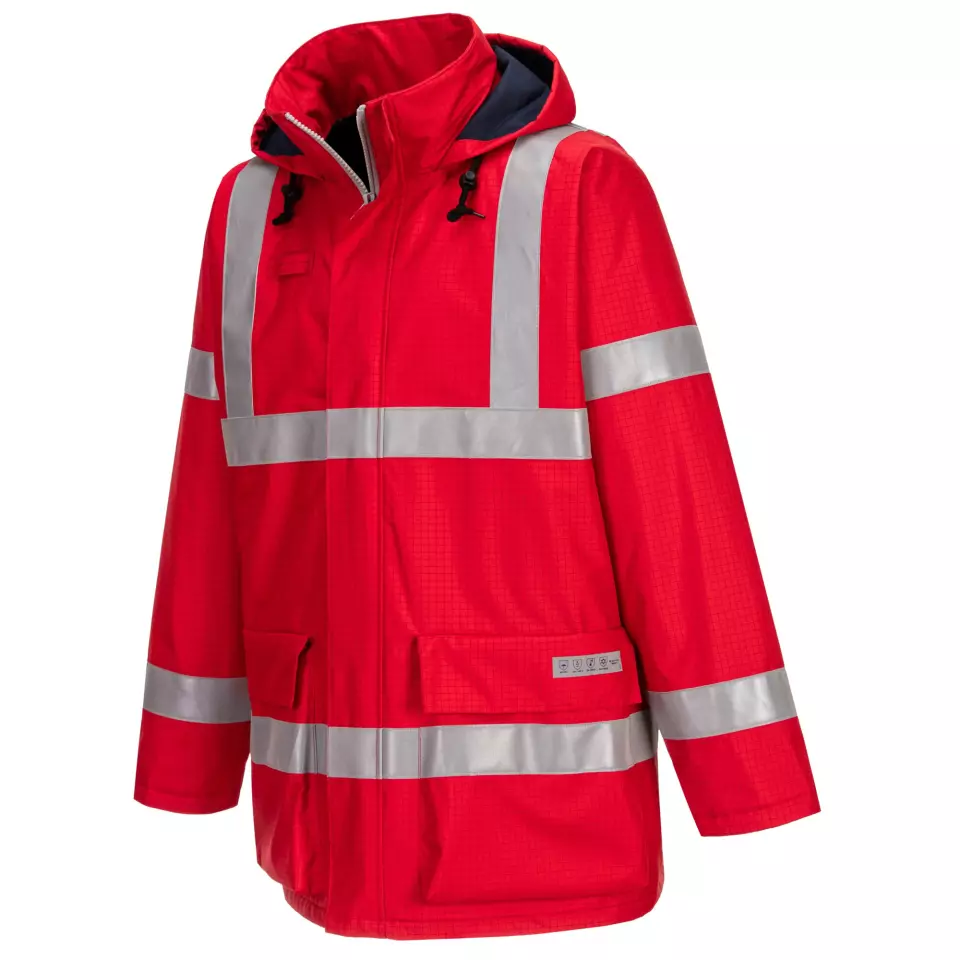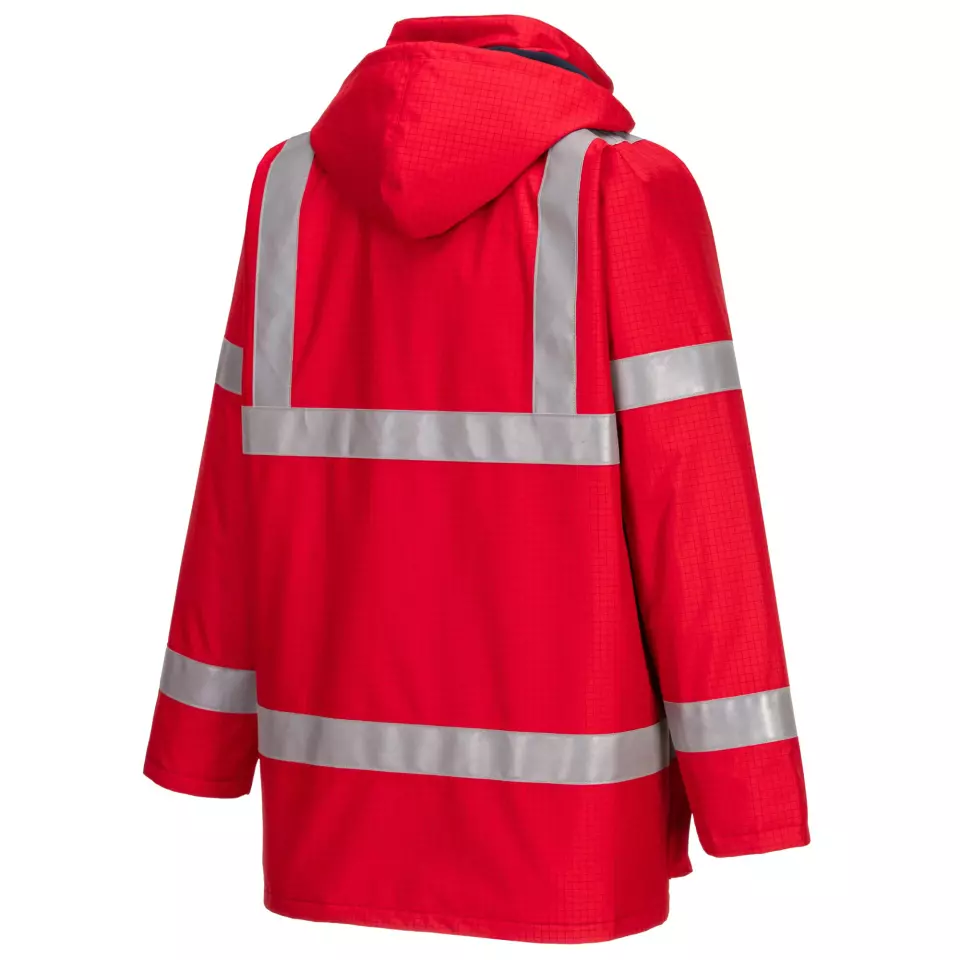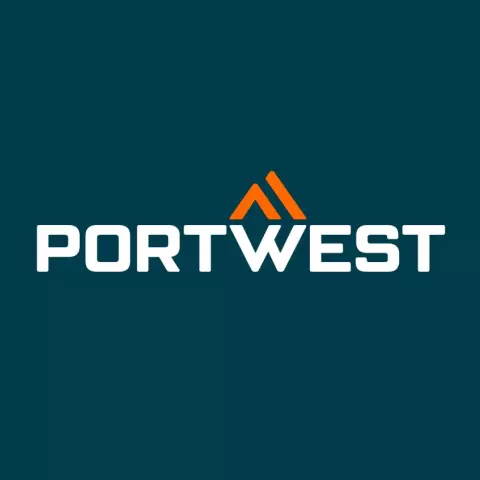Portwest Bizflame Rain Anti-Static FR Jacket, Red
Portwest
visit storeProduct description
This anti-static flame resistant winter jacket provides comprehensive protection for multi-risk environments through its combination of flame resistance, breathability, and waterproof properties. The jacket features flame resistant treated waterproof fabric with taped seams to prevent water penetration, while maintaining breathability for user comfort. Fully lined and padded construction ensures thermal insulation, complemented by practical features including multiple storage pockets, pack away hood, and premium flame resistant reflective tape for enhanced visibility.
Product Features:
- Anti-static properties with flame resistant treated waterproof fabric
- Storm flap front with two-way plastic moulded zip for weather protection
- Pack away hood for added functionality
- Premium sew on flame resistant reflective tape
- Fully lined and padded construction for thermal insulation
Technical Details:
- Waterproof with taped seams preventing water penetration
- Ribbed cuffs for added comfort
- 4 pockets plus internal chest pocket and phone pocket for storage
- Radio loop for easy equipment attachment
- External standards label for quick identification of protection levels
Standards:
- CE certified, CE-CAT III
- EN ISO 14116 Index 3
- EN 1149-5
- EN 13034 Type PB [6]
- EN 343 Class 3:1 X
- EN 342 (0.330 (M².K/W), 2, X)
Keep your phone safe, secure, and always within reach for ultimate convenience on the job.
An inner pocket keeps your essentials secure and easily accessible.
The method used to fasten the jacket or vest, affecting ease of use, security, and weather protection during work activities.
The design and structure of the neckline area, affecting protection from elements, professional appearance, and comfort around the neck and shoulders.
How the sleeve opening closes or fits at the wrist, affecting protection from elements and comfort during movement.
Determines how the jacket fits your body, affecting comfort, mobility, and layering options during work activities.
Indicates the total count of individual pocket compartments available for storing tools, devices, and personal items while working.
Full-length sleeves provide essential protection and warmth, keeping your arms shielded from the elements and workplace hazards.
An integrated hood provides essential head protection from the elements, keeping you dry and focused on the job.
Determines visibility, safety compliance, and professional appearance, with options ranging from high-visibility safety colors to standard work tones.
- Chemical Resistance
- Cold Protective
- Heat & Flame Resistance
- High Visibility
- Electrical Protection
- Water Resistance
- Machine Washable
Request a free sample
Test first and buy later. Visit any product page to request your free sample.
Standards and labels
EN 343 is a European standard for protective clothing against bad weather. It says clothes must be waterproof, breathable, and not let water in. It's used to protect workers in different industries like construction and transportation. Tests must show the clothing meets these standards.
Test results
Waterproofness Class 3EN 343:2019 is designed to ensure that protective clothing provides specific levels of protection against rain, considering its waterproof capabilities. Class 3 in this standard represents the highest level of waterproofness, indicating that the garment successfully resists a high volume of water penetration (more than 13000 Pascal Pressure units after pre-treatment). The test method used involves simulating wet weather conditions, where the fabric is exposed to varying degrees of water projections and pressures to evaluate its resistance. Fabrics that achieve Class 3 certification tend to have undergone rigorous testing such as high-pressure spray tests or being subject to a controlled volume of water for a defined period. These are particularly relevant for professional use in extremely wet environments where the highest level of water resistance is necessary, providing critical protection in conditions from heavy rain to immersion scenarios. This high classification impacts the practical usability of such clothing in industries such as outdoor work, marine activities, or emergency services where maximum protection from water exposure is critical for safety and performance.
Breathability Class 1In the standard EN 343:2019, Breathability Class 1 specifies the lowest (RET > 40) level of breathability for protective clothing against rain. This class is designated for garments that have a tested breathability value which meets the minimum requirement for water vapor resistance according to the specifications laid out in the standard. The practical implication of a Class 1 result is that the garment allows a limited amount of water vapor to pass through, making it suitable for less intensive or shorter duration activities in wet conditions.
Downpour XEN 343:2019 is a standard that delineates requirements and assessment methodologies for protective clothing, specifically tailored to garments intended to offer protection against precipitation and wet conditions.Result X signifies that the garment's performance in resisting water penetration during simulated downpours has not been specified or assessed. The practical implications of this result are notable, as it indicates that the garment may not offer adequate protection against heavy rain and prolonged exposure to wet conditions, potentially compromising wearer comfort and safety, particularly in outdoor work environments where protection from inclement weather is paramount.
Test results
Flame Spread Test Index 3EN ISO 14116:2015 is a European standard established to assess the flame spread characteristics of protective clothing materials, with the aim of ensuring the safety of individuals working in environments with potential fire hazards. Its purpose is to evaluate the flame retardant properties of protective clothing and mitigate the risk of burn injuries. A designation of Index 3 indicates a limited level of flame spread performance, suggesting that the material offers moderate protection against the spread of flames. This result implies that the material may resist ignition to a certain degree and exhibit slower flame propagation compared to materials with lower index values. The test method used to determine this result typically involves subjecting the material to a controlled flame exposure and assessing the extent and speed of flame spread. Practical implications of this result for the product category include indicating that the protective clothing may provide adequate protection in environments with moderate fire risk, but additional precautions or higher levels of flame-resistant clothing may be necessary in higher-risk scenarios to ensure optimal safety for workers.
EN 13034:2005 is a European standard that specifies the requirements and test methods for Type 6 protective clothing designed to provide protection against liquid chemicals. This standard sets criteria for the fabric's resistance to penetration by liquid chemicals and establishes guidelines for the overall design and construction of the clothing. It ensures that Type 6 protective clothing offers reliable protection for workers in industries where they may be exposed to liquid chemical hazards, but it may not be suitable for protection against airborne particles.
Test results
Liquid Chemical Protection Type 6 PBEN 13034:2005 specifies the performance requirements for protective clothing that offers limited protection against liquid chemicals, identified specifically as Type 6 PB (partial body protection). The 'Type 6 PB' designation implies that the protective garment has been tested and confirmed to provide effective defense against light spray and minor splashes of liquid chemicals, but only for parts of the body such as aprons, sleeves, or boots rather than full body suits. This standard tests the fabric's barrier effectiveness by applying a defined volume of liquid to the garment and assessing any penetration or repellence under controlled laboratory conditions. Garments achieving Type 6 PB classification are crucial for tasks in industries like chemical processing or handling where full body coverage is unnecessary, thereby offering flexibility and targeted protection, reducing the risk of chemical exposure to critical areas of the body.
CE Marking is a label that shows a product meets certain safety and environmental standards set by the European Union. To get the CE Marking, a company must test and certify their product meets these standards. CE Marking is required for many products sold in the EU, including electronics, machinery, toys and medical devices. It helps ensure that products are safe for consumers and the environment, and allows for easy trade within the EU.
PPE stands for "personal protective equipment." PPE Category 3 refers to equipment that is complex and provide the highest level of protection such as powered respirators, SCBA, and full body suits. In Europe, PPE Category 3 must meet certain safety standards set by the European Union, which means that it must be designed and manufactured to protect the user without causing harm. Companies that make or sell PPE must prove that it meets these standards. They also must have a quality management system in place, have to be audited regularly by a notified body and have to have a technical documentation.
Portwest delivery terms
Free delivery when you order more than 300,00 € from Portwest
Supplier shipping fee 5,00 €
Brand minimum 20,00 €
112,62 €
Shipping fee is 5,00 € for orders under 300,00 €
Sold in units of one piece
Need larger quantities?
Other products you may like
Recently viewed
Need help?
Get help from our experts
Other products you may like
Similar products you may like
Autonomous sourcing platform
The most efficient way to source and order supplies for your operations
Sourcing
Ordering
List products you’re looking for and we’ll find the best products and prices for you – all for free.
Need help?
Get help from our experts
